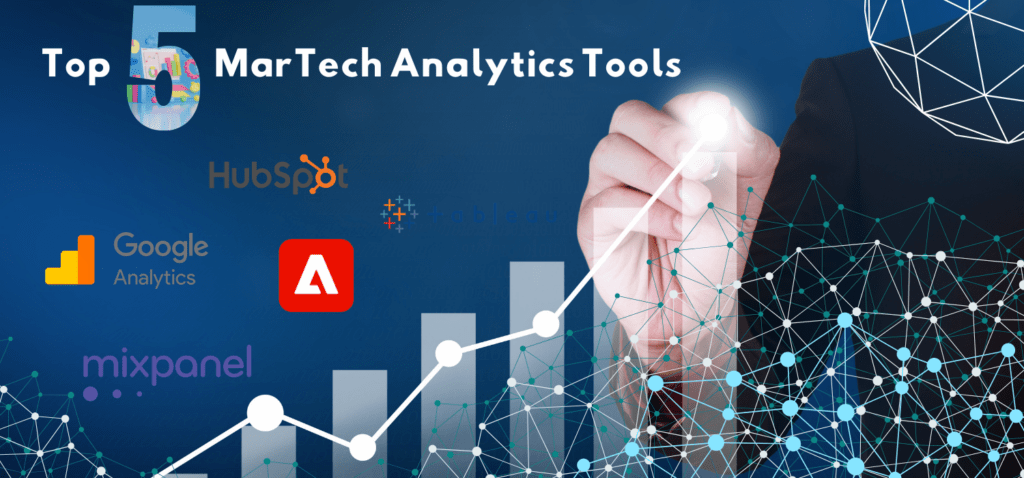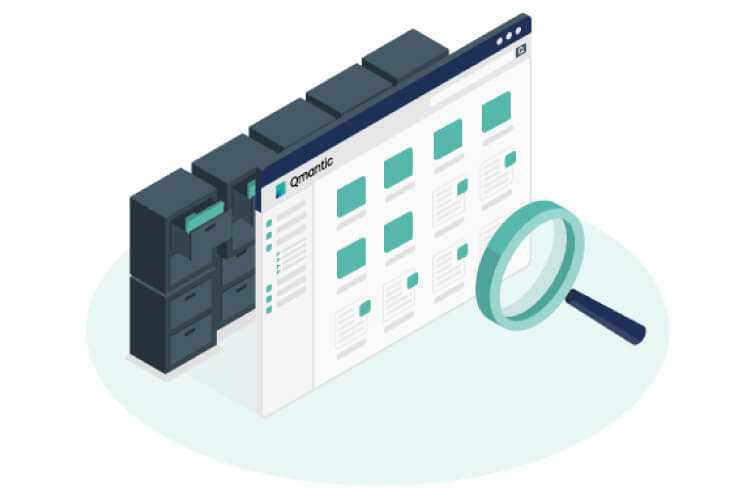What is MarTech?
“MarTech,” a fusion of “marketing” and “technology,” entails leveraging technology and software to support and elevate marketing endeavors. It spans various tools, platforms, and solutions crafted to streamline marketing processes, analyze data, and enhance overall marketing performance.

The goal of MarTech is to leverage technological advancements to make marketing campaigns more effective, efficient, and data-driven. Some common areas of MarTech include:
- Customer Relationship Management (CRM)
CRM software helps businesses manage and analyze customer interactions and data throughout the customer lifecycle.
- Analytics and Data Tools
These tools enable marketers to collect, analyze, and interpret data related to customer behavior, preferences, and campaign performance.
- Content Management Systems (CMS)
CMS platforms allow marketers to create, edit, and manage digital content, including websites, blogs, and social media.
- Email Marketing Software
Tools for managing email campaigns, tracking performance metrics, and automating email workflows.
- Social Media Management
Platforms and tools designed to schedule posts, track social media engagement, and manage social media advertising.
- Search Engine Optimization (SEO) Tools
Software that helps optimize web content for search engines and improve a website’s visibility in search results.
- Advertising Technology (Ad Tech)
Technologies that support digital advertising, including programmatic advertising, ad placement, and analytics.
- Marketing Automation
Platforms that automate repetitive marketing tasks, such as lead nurturing, email campaigns, and customer segmentation.
- Customer Experience (CX) Platforms
Tools focused on improving the overall customer experience, including personalization and customer journey mapping.
Which are top 5 MarTech Analytics Tool for 2024?
1. Google Analytics
Google Analytics a web analytics service provided by Google, falls within the category of web analytics tools. Additionally, it is designed to assist website and app owners in tracking and analyzing user interactions, offering valuable insights into user behavior, traffic sources, and the overall performance of digital properties. This platform enables marketers to track key metrics such as pageviews, bounce rates, conversion rates, and user demographics. Moreover, with its user-friendly interface and a variety of customizable reports, Google Analytics empowers marketers to gain a deeper understanding of their audience, optimize marketing strategies, and make data-driven decisions to enhance the user experience.
Key Characteristics for 2024:
In 2024, Google Analytics is poised to continue evolving to meet the changing needs of marketers. Furthermore, anticipated developments include improved integrations with other Google products, enhanced user privacy features, and more advanced machine learning capabilities for predictive analytics. As privacy concerns become increasingly important, Google Analytics may also introduce new tools or features to help marketers navigate the evolving landscape of data privacy regulations.
2. Adobe Analytics
Adobe Analytics, a web analytics tool categorized under digital analytics solutions, is part of the Adobe Marketing Cloud suite. Furthermore, it focuses on providing comprehensive insights into user behavior and digital marketing performance. Moreover, marketers can leverage its capabilities to track customer journeys, measure campaign effectiveness, and analyze user segments. The tool seamlessly integrates with other Adobe Marketing Cloud solutions, creating a unified platform for end-to-end digital marketing management. Adobe Analytics aims to provide a holistic view of the customer experience, helping marketers optimize their strategies across various digital channels.
Key Characteristics for 2024:
Looking ahead to 2024, Adobe Analytics is likely to enhance its capabilities in real-time analytics, artificial intelligence, and machine learning. Furthermore, the expectations include more advanced predictive analytics features, improved customization options, and increased integration with emerging technologies. As businesses continue to focus on delivering personalized and seamless customer experiences, Adobe Analytics may introduce features to address the growing demand for data-driven insights that drive marketing strategies.
3. HubSpot
HubSpot is a comprehensive marketing automation platform that includes analytics tools. It falls under the category of marketing automation solutions and is designed to assist businesses in attracting, engaging, and delighting customers throughout the entire customer lifecycle. Also, HubSpot provides a suite of tools for inbound marketing, sales, and customer service. In terms of analytics, it offers insights into website traffic, lead generation, and customer interactions. Marketers can track the performance of marketing campaigns, analyze customer behavior, and use data to optimize their strategies. HubSpot’s analytics capabilities are tightly integrated with its other tools, creating a unified platform for managing various aspects of the customer journey.
Key Characteristics for 2024:
In 2024, HubSpot is likely to continue evolving as a comprehensive platform that caters to the needs of inbound marketing. Anticipated developments may include enhanced personalization features, more sophisticated lead scoring algorithms, and improved integrations with emerging communication channels. As the marketing landscape evolves, HubSpot may also focus on providing advanced reporting and analytics features to help marketers derive actionable insights from their data, facilitating more informed decision-making.
4. Mixpanel
Mixpanel is a product analytics tool that belongs to the category of product analytics solutions. It is specifically designed to help businesses understand and analyze user interactions within their applications. Additionally, Mixpanel focuses on tracking user engagement and behavior within mobile and web applications. It enables businesses to gather insights into how users navigate through their products, which features are most popular, and how different user segments interact with the application. Mixpanel’s analytics capabilities include event tracking, funnels analysis, and retention analysis, allowing product teams to make data-driven decisions to improve the user experience.
Key Characteristics for 2024:
In 2024, Mixpanel may continue to emphasize advanced analytics features that provide deeper insights into user behavior. This could involve more sophisticated machine learning algorithms for predictive analytics, improved event tracking capabilities, and expanded integrations with other product management and marketing tools. As businesses increasingly prioritize user-centric product development, Mixpanel may enhance its capabilities to help product teams optimize features and functionalities based on real-time user feedback and data.
5. Tableau
Tableau is a data visualization and business intelligence tool that falls under the category of data visualization solutions. While not exclusively a marketing analytics tool, it is widely used for visualizing and interpreting data across various business domains. Furthermore, Tableau is known for its powerful data visualization capabilities, allowing users to create interactive and shareable dashboards. It can connect to various data sources, enabling marketers to analyze and visualize marketing data in a visually compelling way. Tableau’s drag-and-drop interface and robust visualization options make it a popular choice for transforming complex datasets into actionable insights.
Key Characteristics for 2024:
In 2024, Tableau may continue to evolve with advancements in augmented analytics and improved collaboration features. Anticipated developments could include enhanced natural language processing capabilities for querying data, increased support for real-time data visualization, and improved integrations with other data sources and MarTech tools. As organizations increasingly prioritize data-driven decision-making, Tableau is likely to focus on providing features that empower marketers to derive meaningful insights and communicate them effectively through compelling visualizations.
What is AdTech?
AdTech, short for advertising technology, refers to the use of technology to create, manage, and optimize advertising campaigns and strategies. AdTech encompasses a wide range of tools, platforms, and technologies designed to streamline the advertising process, enhance targeting capabilities, and improve the overall efficiency and effectiveness of digital advertising efforts.
Key components and aspects of AdTech include:
- Ad Networks
Platforms that connect advertisers with publishers (websites or apps) to display ads to the target audience.
- Demand-Side Platforms (DSPs)
Tools that enable advertisers to purchase and manage digital advertising space across multiple ad exchanges in real-time.
- Supply-Side Platforms (SSPs)
Platforms that help publishers manage and optimize the sale of their advertising inventory to maximize revenue.
- Data Management Platforms (DMPs)
Systems that collect, organize, and analyze large sets of data to provide insights into audience behavior, helping advertisers target specific demographics.
- Ad Exchanges
Online marketplaces that facilitate the buying and selling of ad inventory in real-time auctions between advertisers and publishers.
- Ad Servers
Platforms that deliver and track online advertisements, ensuring they are displayed correctly and optimizing their performance.
- Programmatic Advertising
The use of automated systems and algorithms to buy and optimize digital advertising, often in real-time auctions.
- Targeting Technologies
Tools that use data and algorithms to target ads to specific audiences based on demographics, behavior, location, and other factors.
Difference Between MarTech and AdTech
| Aspect | AdTech (Advertising Technology) | MarTech (Marketing Technology) |
|---|---|---|
| Focus | Primarily executes and optimizes advertising campaigns. | Encompasses a broader range of marketing functions beyond ads. |
| Scope | Ad placement, targeting, programmatic buying, ad performance. | CRM, content marketing, email marketing, social media, analytics. |
| Key Technologies | DSPs, SSPs, ad exchanges, ad servers, programmatic tools. | CRM systems, marketing automation, CMS, analytics, social media. |
| Target Audience | Focuses on specific audiences for awareness, consideration, and conversion. | Addresses a wider audience, covering leads, customer relationships, and the entire customer journey. |
| Convergence | Increasing convergence with a trend towards integrated solutions. | Reflects the wider integration of tools to manage the full customer experience. Often referred to as the “AdTech-MarTech Convergence. |
Conclusion
In conclusion, the top five MarTech Analytics Tools for 2024 reflect a convergence of cutting-edge technology, user-centric design, and a commitment to empowering marketers with the insights needed to navigate an ever-evolving digital landscape.

For those looking to embark on this transformative journey, Qmantic stands as a beacon of innovation and efficiency. As a leading player in the MarTech space, Qmantic provides cutting-edge solutions to empower businesses in their marketing endeavors. To experience the transformative capabilities of Qmantic, start your free trial today. Elevate your marketing efforts with Qmantic and unlock the full potential of data-driven success in 2024 and beyond.





